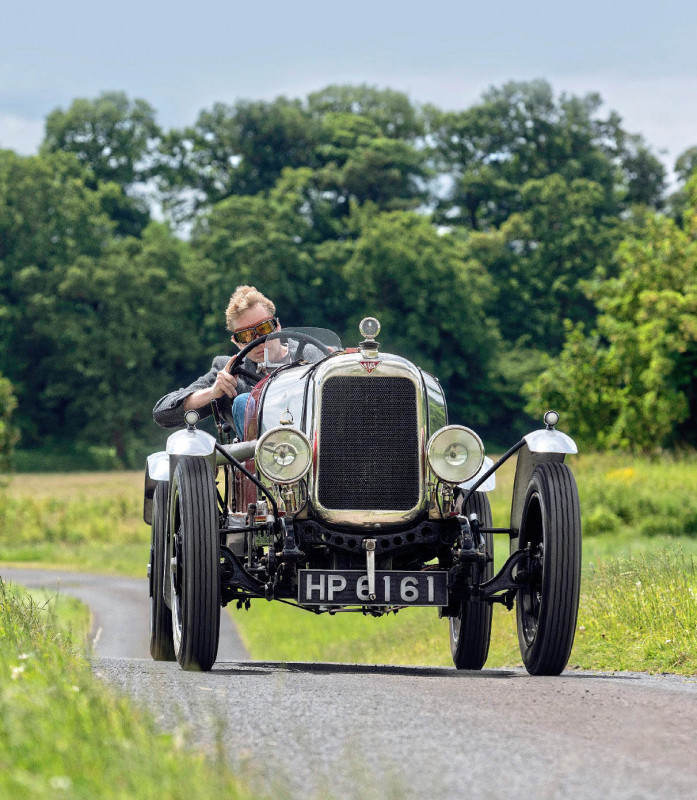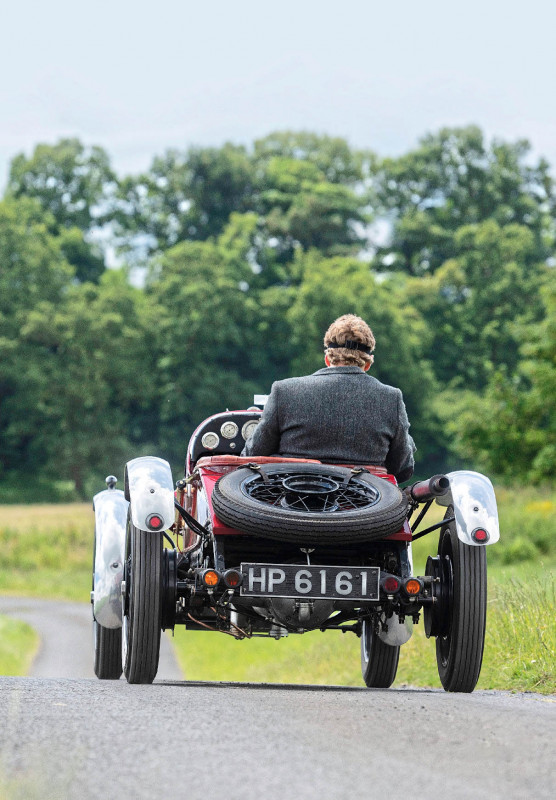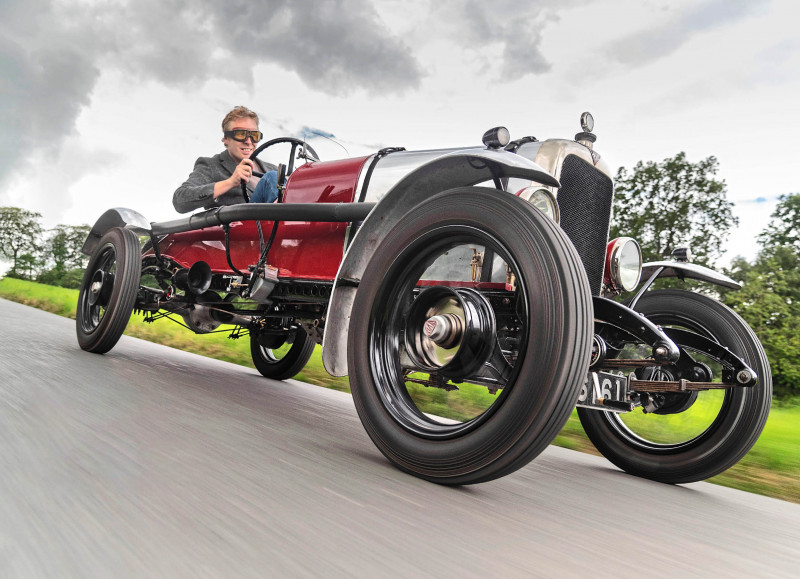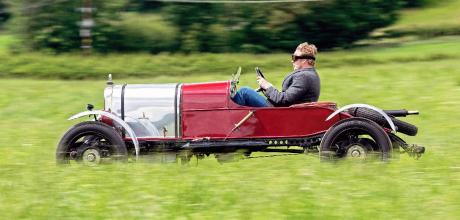1923 Alvis 12/50 ‘Racing Car No 1’
One hundred years ago, Alvis built this car in a quest for competition success to publicise its brilliant new overhead-valve engine. They called it Racing Car No 1 – does it live up to that name today?
Looking After No 1
Braving a fearsome early Alvis 12/50 works racer on public roads
Words NIGEL BOOTHMAN
Photography JONATHAN JACOB
After a century of existence, this car has many tales to tell. It was completed in June 1923, built from a much-drilled Alvis 10/30 chassis of 1921 and a 10/30 crankcase, upgraded by the addition of the brand new 12/50 cylinder block and overhead-valve cylinder head. It was designated by Alvis as 12/50 Racing Car No 1 and was built for sprint and hill climb competition. In the hands of Alvis works driver Major Maurice Harvey, it began winning straight away. But that covers only the first six months of its history. We’ll get into the other 99.5 years after a spell behind the wheel. I’m at Tom Hardman’s showroom on a farm in rural Lancashire, not a bad place to learn how to drive a racing car created before front-wheel brakes were regarded as necessary. Soon I’ll venture out in public, but first – the starting procedure, which is rather involved. There are taps and pipes everywhere. A pump, too, like something you might use to pressurise an insect-sprayer. There is also a nickelplated ignition switch I recognise from my own 1923 Alvis, marked OFF and ON, with a pointer resembling a tiny Bakelite sausage you can turn from one to the other.

It goes like this. Turn on the fuel taps. Pump some air pressure into the fuel tank with the plunger on the outside left of the cockpit, until the gauge shows anything other than zero. Reach through the hand-hole in the offside bonnet panel and tickle the carburettor on the float chamber to flood it. Then, with the ignition off, use the starting handle to turn the engine over a few times to draw in some mixture. Retard the ignition with the timing control lever and turn the switch to ‘ON’. Ask Tom Hardman to apply the choke, which is nothing more than a special piece of flat metal on a keyring in Tom’s pocket that he presses to the mouth of the carburettor. Move the starting handle down slowly and find some resistance. Then give a swift pull upwards – never try to start on a down-stroke, for fear of a violent kickback – and it should burst into life.

To my astonishment, it works first time from stone cold. Tom has clearly learned the drill very well and passed it on exactly. Racing Car No 1 settles into a pocketa-pock idle and sits there, trembling lightly and scenting the air with Castrol R. So far, so docile – and, as hundred year-old racing cars go, something of a pussycat. Will it be quite so obliging to drive?
Thanks to the cut-down cockpit side, your right knee can splay out as you hunker down behind the aero screen. The biggest worry is moving your right foot from the central accelerator and passing it under the steering column to the brake pedal on the right. Then there’s the gearlever, waiting outside the cockpit to produce a cringe-inducing crunch when engaging gear from a standstill. This car has no clutch stop, and the cone clutch assembly would normally be well enough lubricated to slow down and stop spinning the gearbox input shaft soon after you dip the pedal, but this one has seen little use since before Covid. Still, if you set a slow idle, and take some speed off the whirling metal by half-engaging second gear for a moment or two, you can click it smartly into first. Clutch pedal up and away you go.

Now it gets easier. The flywheel is quite light and the gearbox ratios seem more evenly spaced than other vintage Alvis gearboxes, so you double-declutch smartly into second, buildspeed, tap-dance smartly again into third and then again for top. Which isn’t worth bothering with below about 40mph, because the tall back axle ratio needs revs on the clock to allow the engine to pull cleanly. The rear axle ratio is high and the light flywheel combines with Racing Car No 1’s relative lack of torque (it sacrifices low-revving grunt for a very high redline, up near 5000rpm) to make it less than happy in slow traffic… as I soon discover when I venture out, managing to stall the engine at a junction in the village. Cue red-faced acrobatics as I leap forth and repeat the starting palaver.
I had expected No 1 to be geared lower for hill climbing. The rear axle ratio feels rather tall, which means midrange acceleration is stronger than it is off the line. The centre of gravity feels a long way up, so the high-ratio steering (pleasingly light and direct) needs a careful touch if you’re not to unbalance the car during sudden changes of direction. There are rod-actuated brakes on the rear wheels only, but equally large handbrake shoes alongside them in the same drums. Using the latter (or a bit of both) scrubs off some speed. But not much. Mind you, if they were more powerful you could lock the two skinny tyres very easily with so little weight over the back of the car. In its era No 1 must have been formidable, because only a week after completion it was making Fastest Time of the Day.
The hill climbs at which it triumphed are now almost forgotten: South Harting, Sharnden, Ringinglow, Peak Hill. Kop Hill has made a comeback as a classic event. The Alvis won speed trials, too – in Southsea and Thetford – and was sometimes competing twice or three times in a week.
Two other 12/50 racers followed No 1, completed by early September 1923 to much the same specifications, but with streamlined Brooklands bodies. They were immediately entered for the track’s major event that year — the 200 Miles Race, held at season’s end in October. This success has become a part of Alvis legend, because it did much to make the company’s name – though knowing that it came on the back of a highly successful summer on the hills for Number 1, and that the factory would have learned lessons from how No 1’s engine was behaving, helps put the win in context. Major Harvey took one of the two new racers and defeated rapid but less reliable opposition, including Malcolm Campbell in a twin overheadcam supercharged Fiat. Harvey and riding mechanic George Tattersall won at an average 93.29mph, a new class record.
The Autocar offered glowing praise. ‘The sharp bark of its smooth engine never missed a beat, nor faltered, nor altered its pitch. It ran as Alvises run in everyday use – sturdy, swift and steady.’ It also averaged a remarkable 24mpg, humming along at 4000rpm. Clearly it had the makings of an impressive road car. Alvis’s Managing Director, TG John, didn’t think it got sufficient press attention at the time. By 1929, though, he said, ‘There is no doubt that without competitions and racing, it would have taken us another ten years to get as far as we have now.’
They had indeed got a long way. By 1929, Alvis had sold almost 3000 12/50s and it had secured a reputation as a quick, sturdy and well-engineered machine – something the model would never lose. The success of the 12/50 funded the innovative (though loss-making) Front Wheel Drive and the six-cylinder Silver Eagle that led eventually to the Speed 20. Racing Car No 1 represents the foundation on which that success was built.
You can feel it in every hill and sweeping corner. Partly this is thanks to No 1’s low weight, which reveals everything in greater detail, but it’s mainly down to the crackling overhead-valve engine. I find myself wondering whether to overtake a dawdling hatchback with a blip down into third, then I remember what I’m driving… and those brakes. You wouldn’t even consider such a move in any other four-cylinder, 1.5-litre car from 100 years ago. A ‘bullnose’ Morris Cowley, a typical side-valve example of the 12hp class, makes 40mph feel like plenty. This car will do twice that and more – and even in roadgoing tune, a 12/50 SA could pass 70mph. You’d need a Bentley 3 Litre to keep up, and in 1923 they cost £1000 for a rolling chassis, sans coachwork. A 12/50 SA Sports was £550, all in.
So what happened to No 1 after the limelight faded? Well, it was transferred at the end of the 1923 season to racing motorcyclist and Alvis agent Tom Simister, who raced it successfully on the sands at Southport, then sold it to Jack Linnell in 1924 for £250. Linnell used No 1 as his daily car, commuting to work, going on camping trips and even making it the basis for carnival floats, dressed as a Viking longship and a beer-transporting aeroplane, amongst others. Yet he also raced it, winning the open Alvis race at Brooklands in June 1929.
During the war it was put out to grass – literally, because a mine detector and a scythe were needed to find it again in 1945. Robert Wicksteed, a young chap who was to have a life-long influence on No 1, got to know Jack Linnell around this time and asked if he could recondition the engine and build new sports bodywork to replace the mouldering race body, which he duly did in 1948. Linnell, an exceptionally generous sort, seems to have loaned the car to Robert on a semi-permanent basis, so Wicksteed was free to use it as his daily car and indulge in VSCC competition. On the way to Silverstone in 1949, Wicksteed swerved to avoid a bus and rolled the car, squashing the bodywork and requiring 16 stitches in his face and forehead. He rebuilt the body again in similar form.
Jack Linnell took the car back when Robert Wicksteed got married soon afterwards, but in the Sixties Wicksteed was looking after it once more. He – and the car – were invited to a 50th anniversary bash for Alvis at the old works in 1970, and Wicksteed decided with only eight days to go that he should return No 1 to its original look by repairing and refitting the original racing body. He ended up working the final 27 hours before the event without a break – and arrived with the car back in 1923 trim, albeit with the paint still wet.
Sundry engine rebuilds followed, with a broken conrod, a fractured oil pipe and ‘run’ big end bearings accounting for a lot of man-hours. On the whole, though, Wicksteed enjoyed a successful time in VSCC competition, barring a roll-over at Cadwell Park in 1980. Linnell died in 1983 and ownership passed officially to Wicksteed, who continued campaigning the car for another year until it threw a rod once more. The damage to the engine turned the car into a static exhibit for many years, and then in the late Nineties Wicksteed was diagnosed with cancer. In the time before his death in 2002, he was able to make plans with his son-in-law, Robert Hunt, for the engine rebuild. In the end, the younger Robert embarked on a full nut-and-bolt restoration that took 4500 hours, with enough fascinating challenges to fill another article on its own. In 2006, Robert Hunt began HP 6161’s latest phase of active competition – and it’s been a regular sight at VSCC events ever since, with returns to hills such as Prescott particularly valued. Now in the hands of a new owner based overseas, No 1 will stay at Tom Hardman’s storage facility, allowing continued appearances at various events in the UK and Europe. Good thing, too – it’s still a competitive car. I’ve reached the roads around Stonyhurst College, where an open stretch of tarmac allows a real turn of speed at last, with the engine spinning to far higher revs than you’d normally try on a long-stroke engine design that’s a century old. Big inlet ports breathe clearly, the straight-through exhaust barks and blatters, and No 1 gets into its stride. It has a characteristic common to all proper competition cars, and probably to racehorses and greyhounds, too – it’s looking for something to race.
As I go faster still, the wind blast over the aero screen makes me grateful for my goggles. This blend of light steering and a loping, pliable ride suggests what a joy it would be to put some fast miles around a suitable circuit, or perhaps one of the more flowing hill climb courses where the clear view of the front wheels would allow you to apex with perfect accuracy. No 1’s performance won prizes and publicity, but more relevant to the 12/50’s success as a road car was this capable, competent ease with which it maintains a high average speed across country. That’s not to say it would have been easy to win those trophies back in 1923. One of the strongest impressions Alvis Racing Car No 1 provides is the sense of exposure – not just to the elements, but to all that hot oil, hot water, fuel and whirling metal… and indeed to the spear with the steering wheel on the end, pointed straight at my heart.
They must have been intrepid souls – not only Major Harvey, but Linnell and Wicksteed, too. With this car they certainly did Alvis proud.
Thanks to: Tom Hardman, Robert Hunt
TECHNICAL DATA 1923 Alvis 12/50 ‘Racing Car No 1’
- Engine 1496cc inline four-cylinder, ohv, Solex 40MV carburettor
- Max Power (est) 68bhp @ 4400rpm;
- Max Torque 70lb ft @ 2500rpm
- Transmission Four-speed manual, rear-wheel drive
- Steering Alvis worm and sector steering box
- Suspension Front: beam axle, semielliptic leaf springs, Hartford friction dampers. Rear: live axle, semi-elliptic leaf springs, Hartford friction dampers
- Brakes Front: none. Rear: cable-operated drums Performance
- Top speed: 87mph;
- 0-60mph: 18sec (est)
- Weight 650kg (1450lb)
- Fuel consumption (est) 25mpg
- Cost new n/a but £550 for a roadgoing version
- Value now circa £130,000
‘It has a characteristic common to all competition cars – it’s looking for something to race’
‘It won speed trials, and was sometimes competing twice or three times in a week’
Driver’s weight probably exceeds that of bodywork.
Sitting low enough to benefit from aero screen is tricky.
Dabs of paint on dash and tacho are racing driver’s aids Simple Solex carb: a brass jar with an organised leak Chassis is riddled with weightreducing holes Race tune, but still very like a standard 12/50 engine
Fuel pressure pump within reach, outside-left. Car is still eager, still capable – just don’t get carried away!
Chassis-width body requires staggered seating Silencer and spare wheel concessions to road use Three-branch manifold also used on Sports model 12/50 road cars Soft-ish springs and firm dampers produce loping ride
OWNING AN ALVIS 12/50
‘Alvises are some of the most practical of all vintage cars,’ says Tom Hardman. ‘They have enough go to mix it with A- and B-road traffic and will cover long distances without drama, though motorways aren’t much fun. They’re simple cars and a reasonably hands-on owner will be able to do most jobs themselves. The Alvis gearbox is reckoned to be tricky to change without crunches, but when you get used to it, it’s fine, as is the central accelerator. The Alvis Register has an amazing spares service and there are several proper Alvis specialists out there who can cope with the largest tasks, so the help is still available. You can find them with open and closed bodies, and there are quite a few specials around, too. Values can cover £16,000 to £55,000, but you’ll find most between £20,000 and £40,000… rather more for a unique racing car, though!’
Left: July 1923 in Coventry – completed just days earlier Above: West Harling, Norfolk, August 1923: a second-fastest time of the day and class win in the standard start kilometre – 36.22 seconds Above: Linnell wins the Alvis meeting at Goodwood in 1929, despite somewhat fresher opposition Left: Linnell in the pits after his Brooklands win, for which he was awarded a cup by Alvis dealer Henlys One of Linnell’s more inspired carnival float designs — that is indeed No 1 under there Jack Linnell packing his fan club into No 1 soon after purchase in June 1924. Where there’s a will… Left: on his way to Silverstone in 1949, Robert Wicksteed swerves to avoid a bus and rolls the car. Stitches for Bob, a new body for No 1 Above: 1973, and Wicksteed is still competing, here winning a prize at Silverstone in a one-hour high speed trial.
‘A racing car created before front brakes were seen as necessary


